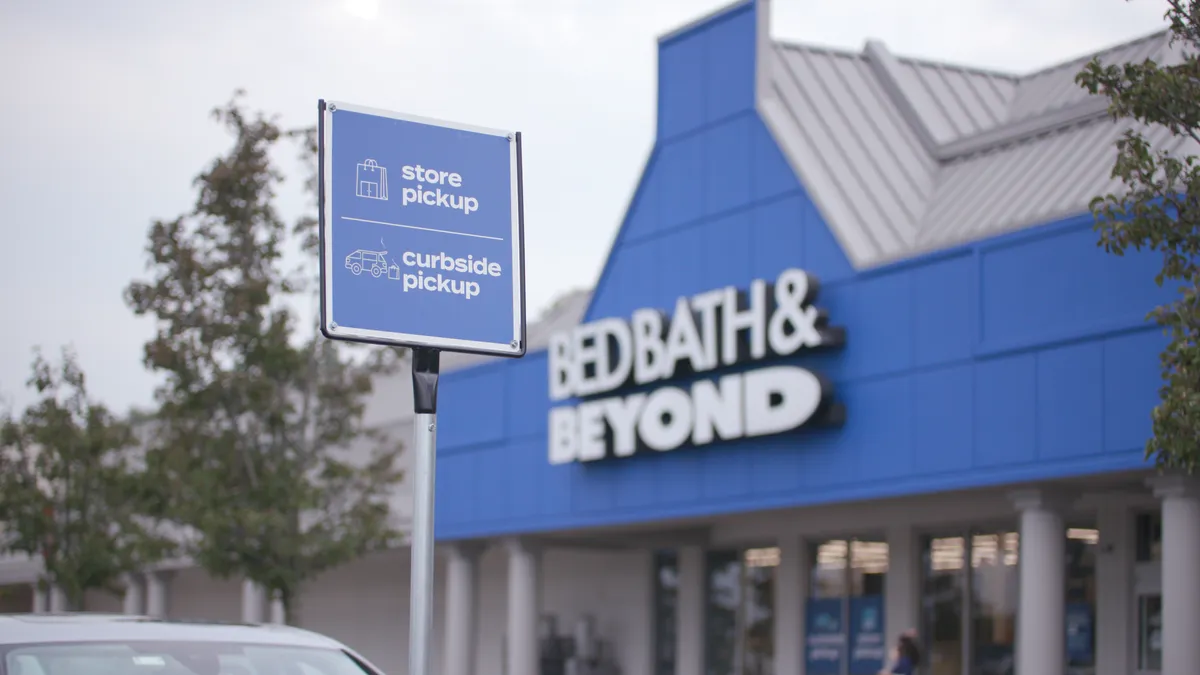Bed Bath & Beyond is approaching its $250 million supply chain investment through a strategy that blends physical with digital.
ERP upgrades, inventory management systems, distribution centers and store-to-fulfillment conversions are all parts of modernizing a supply chain previously described as "primitive."
COO John Hartmann called the store replenishment "noncompetitive" last week on an earnings call.
Currently, it takes 35 days for the retailer to replenish its stores with inventory. The goal is under 10 days.
Bridging that 25-day gap starts with regional distribution centers, according to Hartmann.
It's a common-sense model, the COO said in January. Bed Bath & Beyond will move away from its network of dozens of cross docks that consolidate vendor shipments, toward regional warehouses that replenish stores.
The retailer plans to stand up four regional distribution centers with the help of a third-party logistics provider yet to be selected. Bed Bath & Beyond chose the 3PL route for "increased financial flexibility and reduced capital expense," Hartmann said in January. Last week, he said the retailer is in the "final stages of selection" following a request-for-proposal process.
The partnership will first focus on two regional centers, one in the Northeast and one in the West.
Having well-replenished and well-stocked stores is critical to Bed Bath & Beyond's strategy of "omni-always."
Like many retailers, it launched buy online, pick up in store and curbside pickup when the pandemic made consumers wary of shopping in-store. The retailer fulfilled 41% of digital orders via stores in its most recent quarter, up from 36% the quarter before — though a far cry from Target, which fulfilled 95% of online orders from stores in Q4.
Improved stock status can also stem from SKU rationalization, particularly at Bed Bath & Beyond, known for its prolific assortment of products and items stacked sky-high on store floors.
"We are overhauling our merchandising assortment to focus on more productive items, eliminating redundancy, and adding newness in owned brands," said Joe Hartsig, executive vice president and chief merchandising officer.
That leaves store employees with less inventory to manage, "which makes it easier to restock and leaves more time to provide great customer service," Hartsig said.
Physical infrastructure alone won't cut down store replenishment times or stockouts, which is why technology is a large part of Bed Bath & Beyond's supply chain overhaul.
A slide deck presented alongside the earnings call describes the current technology and data as aged, poor quality, siloed and unreliable.
"Having the right retail technology in place is fundamental to our business transformation," Hartmann said.
Building the tech stack started off with the selection of an ERP system from Oracle to replace Bed Bath & Beyond's legacy tech. The tool provides real-time data and is designed to apply analytics to inventory management and product life cycles.
Then in March, the retailer announced its next tech partnership, this one with Relex Solutions for automated forecasting, planning and replenishment. The cloud-based system is designed to improve Bed Bath & Beyond's in-stock status and inventory turnover.
Before the $250 million investment, the retailer began a partnership with Google for demand planning and forecasting.
Bed Bath & Beyond's modernization, whether digital or physical, points to a common theme of a better balance sheet for the retailer. Improved forecasting and inventory management could boost sales and reduce markdowns. Warehouses closer to stores reduce logistics costs, a headwind the retailer faced when its primary carrier, FedEx, raised prices. The retailer also converted about 25% of stores in the U.S. and Canada into regional fulfillment centers for local delivery, Hartmann said.
"Our digital-first omni-always strategy is working," Hartsig said, pointing to digital comps growing 99% under the Bed Bath & Beyond banner.
Wedbush analysts called the retailer "a compelling story," given the overhaul of supply chain and investment in omnichannel.
"But BBBY will need to show improving market share performance and gross margin upside for investors to develop strong interest in the name," a research note from the firm reads, which rates the retailer as neutral.
This story was first published in our weekly newsletter, Supply Chain Dive: Operations. Sign up here.














